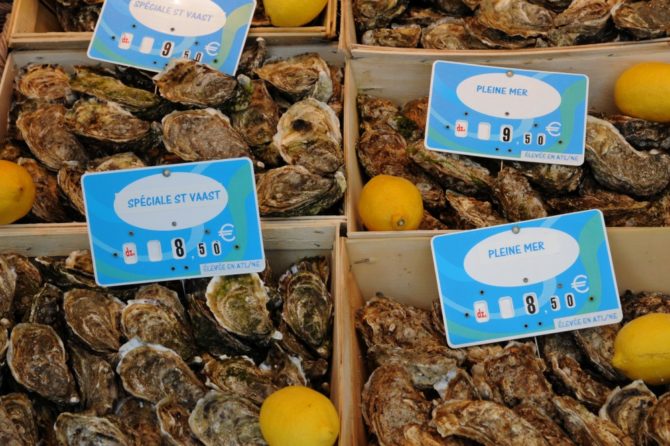The World Is Your Oyster
Winter arrived so suddenly this year there was no time to shake off the warm-weather mantle of garden tomatoes and eggplant, the juiciness of ripe peaches and plump berries. Our arrière-saison, or Indian summer, was so languorous that its sudden end caused ripples of vegetal confusion, making the warm center of onions turn spongy, freezing the last cherry tomatoes on the vine, turning the broccoli black in the field. The shock also caused a certain culinary delirium, because with the cold came an intense desire for winter foods before they themselves were ready to show. But now everything has settled firmly into the chilly season, and with that has come—in my quarters at least—an absolute and endless craving for the briny oyster.
Oysters are clearly a cold weather food, good during months containing the letter “r”, as the old rule says. What does the “r” have to do with it? Those are the cold months, the rule of the letter an easy one to follow. When cold arrives and water temperatures fall, the oyster firms up from its spawny summer softness, becoming crisp and appetizing once again.
There are oyster lovers who eat the bivalves year-round. How they accommodate their summer lack of vigor and vibrancy is beyond me. In summer the oyster wants one thing and one thing only—to reproduce. I, for one, am more than happy to leave them to do so.
The “r” rule isn’t perfect; the September oyster hasn’t always returned to its buff, crisp state. By October all is well, the oyster firm, the oyster-lover safe and secure.
Come the holidays and oyster growers in France are busy packing, selling, shucking the 130,000 tons they produce each year, which makes them the largest producer of oysters in Europe, the fourth largest in the world. Their countrymen consume nearly a third of their production, and almost all of those are eaten on the half shell.
There is an art to shucking, as anyone who has watched an écailleur or professional shucker knows. In goes the knife, and with a quick twist that top shell is off. A tip of the wrist and the brine—and any chips of shell—are gone, the oyster ready to set on a bed of ice covered with a layer of seaweed.
The bottom adductor muscle of the oyster is left attached to the shell; the tiny fork served with the oyster in restaurants is there to gently but firmly scrape it free. Like a fine white wine, an oyster should be served chilled, not freezing cold. If they’re shucked and refrigerated, remove them fifteen minutes before you plan to serve them. Don’t put them on the ice until right before they go to the table. Coarse salt is a good bed for oysters if ice is lacking. The one caveat here is not to put them on the salt too soon, either. It has the converse effect of ice, and warms them up.
A typical French accompaniment to oysters on the half shell is a simple combination of diced shallots and red wine vinegar called mignonette. It is intended to be spooned into the oyster right before slurping it from the shell. Another required accompaniment is rye bread with salted butter, preferably from Brittany. A squirt of lemon juice is also commonly acceptable.
I veer from most on this. To me, anything added to an oyster is simple pollution. Each oyster’s flavor is a hymn to its particular watery terroir, unlike anything else, impossible to reproduce. I reserve shallots, vinegar and lemon for salads; all my oysters require is a fine, lightly chilled Entre-Deux-Mers (I love Château Turcaud) or any other sauvignon blanc wine. Champagne is delicious too.
As for the cooking of an oyster, this comes along later in the season when the trembling magic of the oyster on the half shell is fading. Then, poaching an oyster in its liquid and serving it atop a perfectly sautéed steak which has been covered in lightly sautéed shallots is a miracle. A simple oyster stew, which consists of oysters lightly simmered in cream with a minor sprinkling of pepper right before serving, is gorgeous, as are oysters baked in their bottom shell, just long enough for a dab of butter and a drizzle of pommeau (apple sherry) to melt into their juices.
We tend not to fry oysters in France, although I do every now and then as a paean to my American roots. I don’t have cracker crumbs—I use a simple flour dusting instead and, yes, I do offer Tabasco alongside. I love to serve these to French friends, who view them as an exotic oddity, though delicious.
For the winter visitor to France, the array of oysters can be a bit confusing because there are so many designations. It’s quite simple, really. There are two basic types of oyster in France, the creuses and the plates. The creuses are a cupped-shelled oyster originally from Japan, and they are the most common. The plates are very round and flat, and are the rare glory of French estuaries, primarily from Brittany but also from farther down the coast in Poitou Charente and in the Bay of Arcachon. While the creuse varieties offer a range of poetically gentle to arrestingly briny and salty flavors, the plate is consistently deeper and more metallic in flavor, less romantic than the creuse but, somehow, equally or even more alluring.
Typically, oysters are listed on a restaurant menu according to size and number, or according to broad categories. For the creuses those broad categories are Fines, Spéciales, Fines de Claires, Spéciales de Claires, Pousse en Claires and Papillons (very small). For the plates the broad categories are Belon or Marennes.
At some restaurants, however, the place of origin or the producer’s name is mentioned. There are dozens, but here is a selection: for creuses, Saint-Vaast (Normandy’s Cotentin peninsula); Fines d’Isigny (Normandy); Creuses de Bretagne, Prat-ar-Coum, Jacques Cadoret, Creuses de Paimpol (Brittany); Gillardeau, currently considered one of the top-quality oysters in France, Huîtres du Morbihan (southern Brittany); Huîtres Creuses du Bassin d’Arcachon (Aquitaine); and Huîtres de Bouzigues (from the Mediterranean).
The plates are calibrated from 000 to 6—the smaller the number, the larger the oyster.
Once you’ve experimented with oysters you will find your favorites. I love the Saint-Vaast, but of course I live in Normandy; I adore the Belon, and I think the Gillardeau and the Prat-ar-Coum are heaven. But then I’m an oyster lover, and have rarely met one that didn’t make me swoon.
I leave you with a recipe for oysters baked briefly in the oven. I hope you will try it. But I hope even more that you will have your next serving of oysters—in France preferably, and before that pesky “r” disappears from the month—raw on the half shell. Have a slice of lemon ready if you must, or even a small bowl of mignonette. But first, slip one into your mouth without any window dressing, and taste the flavor of the sea, the shore, the wind and the inevitable clouds scudding across the sky.
WARM OYSTERS WITH POMMEAU DE NORMANDIE / HUITRES TIEDES AU POMMEAU DE NORMANDIE
This recipe wins over everyone for its purity and simplicity. Try to have help while you are making this so the oysters are hot when served. Pommeau is an aged apple liqueur made from unfermented apple juice and Calvados. Use sherry if you can’t find pommeau.
2 dozen small to medium oysters, scrubbed, in the shell
2 tbsp (30 g) unsalted butter, melted
1/4 cup (60 ml) pommeau
1. Preheat oven to 450° F (230° C).
2. Arrange oysters on a baking sheet (if necessary, set them on a bed of coarse salt to keep them stable).
3. Place oysters in the oven and bake just until shells open, about 5 minutes. Remove from oven and, using an oyster knife, cut the muscle inside the top shell of each oyster to free the shell. Discard the top shells.
4. Drizzle each oyster with an equal amount of melted butter, then with an equal amount of pommeau. Serve immediately while oysters are still hot.
Serves 2 to 4, depending on the enthusiasm of the eaters
From the France Today archives
Share to: Facebook Twitter LinkedIn Email
Leave a reply
Your email address will not be published. Required fields are marked *





